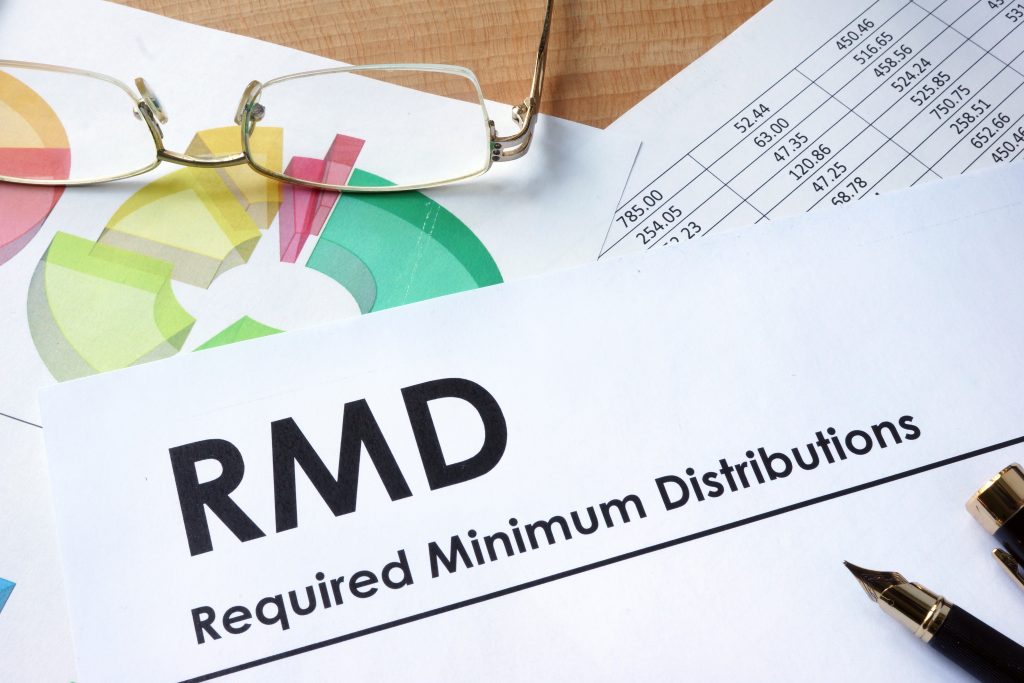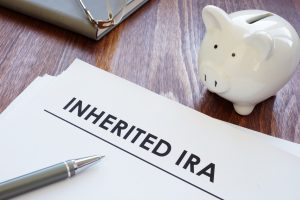Nelson Capital Management

Required Minimum Distributions (RMDs) are the minimum amount that a retiree must withdraw from retirement accounts each year. They apply to traditional IRAs, SEP IRAs, SIMPLE IRAS, 401(k)s and 403(b)s. They do not apply to Roth IRAs or Designated Roth accounts in a 401(k) or 403(b). The distribution is taxed as ordinary income in the year it is withdrawn.
 The SECURE Act of 2020 pushed the age at which you are required to start taking RMDs from 70½ to 72. SECURE 2.0 pushed it further to ages 73-75 depending on the year in which you are born. The calculation for the amount of an RMD is based on the account balance at the end of the previous year and a life expectancy factor determined by IRS tables. It starts around 4% of the account balance and increases as life expectancy decreases. The first RMD must be taken by April 1st of the year after the account owner turns the applicable RMD age and future RMDs must be taken by December 31st of each year. The penalty for failing to take an RMD is 25% but can be reduced to 10% if corrected within two years.
The SECURE Act of 2020 pushed the age at which you are required to start taking RMDs from 70½ to 72. SECURE 2.0 pushed it further to ages 73-75 depending on the year in which you are born. The calculation for the amount of an RMD is based on the account balance at the end of the previous year and a life expectancy factor determined by IRS tables. It starts around 4% of the account balance and increases as life expectancy decreases. The first RMD must be taken by April 1st of the year after the account owner turns the applicable RMD age and future RMDs must be taken by December 31st of each year. The penalty for failing to take an RMD is 25% but can be reduced to 10% if corrected within two years.
The rules around RMDs for Inherited IRAs were changed significantly by the SECURE Act. Prior to 2020, non-spouse beneficiaries were able to stretch distributions from an Inherited IRA over their lifetime with RMDs based on their life expectancy. The SECURE Act instituted the 10-Year Rule where non-spouse beneficiaries must withdraw the full balance of the Inherited IRA within 10 years. IRAs inherited prior to 2020 are grandfathered into the old rules and not subject to the 10-Year Rule. Certain types of beneficiaries, known as Eligible Designed Beneficiaries (EDBs), are also not subject to the 10-Year Rule and may take RMDs based on their life expectancy. These beneficiaries include the spouse or minor children of the deceased IRA owner, disabled or chronically ill individuals, and individuals not more than 10 years younger than the IRA owner. Minor children are subject to the 10-Year Rule once they reach the age of majority.
The original law did not offer guidance on RMDs for Inherited IRAs but the IRS recently issued final rules stating RMDs must be taken from Inherited IRAs each year throughout the 10-year period. However, this does not go into effect until 2025. This applies to both Inherited IRAs and Inherited Roth IRA. Withdrawals of contributions from Inherited Roth IRAs are tax free. Withdrawals of earnings from an Inherited Roth IRA are also tax free unless the account is less than 5-years old at the time of the withdrawal.
Individual investment positions detailed in this post should not be construed as a recommendation to purchase or sell the security. Past performance is not necessarily a guide to future performance. There are risks involved in investing, including possible loss of principal. This information is provided for informational purposes only and does not constitute a recommendation for any investment strategy, security or product described herein. Employees and/or owners of Nelson Capital Management, LLC may have a position securities mentioned in this post. Please contact us for a complete list of portfolio holdings. For additional information please contact us at 650-322-4000.
What is an RMD?
Required minimum distributions (RMDs) are withdrawals the IRS requires owners of IRAs (excluding Roth IRAs) take from their tax-deferred accounts each year, starting at age 72 (age 70½ if you attained age 70½ before 2020) or after inheriting any IRA account for individual beneficiaries. If you withdraw less than your RMD, you may owe a 50% penalty tax on the difference.
RMDs are designed to ensure that investments in IRAs do not grow tax-deferred forever and this carries over to the beneficiary of the IRA. The rules for how IRA beneficiaries must take RMDs will depend on when the account owner passed away.
 Inherited RMD calculation methods
Inherited RMD calculation methods
The date of death of the original IRA owner and the type of beneficiary will determine what distribution method to use. You must take an RMD for the year of the IRA owner’s death if the owner had an RMD obligation that was not satisfied.
For an inherited IRA received from a decedent who passed away after December 31, 2019:
Generally, a beneficiary is required to liquidate the account by the end of the 10th year following the year of death of the IRA owner (this is known as the 10-year rule). During the 10-year period, the beneficiary may take distributions of any amount at any frequency. There are exceptions for certain eligible designated beneficiaries, defined by the IRS, as someone who is either:
· The IRA owner’s spouse.
· The IRA owner’s minor child (once the child reaches age of majority, they are subject to the 10-year rule).
· An individual who is not more than 10 years younger than the IRA owner.
· Disabled (as defined by the IRS).
· Chronically ill (as defined by the IRS).
For an inherited IRA received from a decedent who passed away before January 1, 2020:
When a beneficiary becomes entitled to an IRA from an account owner who died before he or she was required to begin taking RMDs (April 1st of the year following the year in which the owner reached RMD age), the beneficiary can choose one of two methods of distribution: over his or her lifetime or within five years (the “five-year rule”).
Lifetime distribution
Spouse as sole primary beneficiary:
If the owner’s spouse chooses to take the IRA as a beneficiary rather than assume the account, he or she can choose when to begin taking RMDs on the basis of his or her own life expectancy. The spouse must begin taking RMDs by the later of December 31 of the year after the owner’s death or December 31 of the year the owner would have reached RMD age. If the owner’s spouse chooses to assume the IRA, he or she must begin taking RMDs by the later of December 31 of the year after the owner’s death or April 1 of the year after the spouse reaches RMD age.
Non-spouse and when spouse is not sole primary beneficiary:
An individual non-spouse beneficiary must begin taking RMDs on the basis of his or her own life expectancy by December 31 of the year after the owner’s death. Multiple beneficiaries can take RMDs on the basis of their own life expectancies if all of the beneficiaries have established separate accounts by December 31 of the year after the owner’s death and starting in that year. If all multiple beneficiaries have not established separate accounts by that December 31 date, all beneficiaries must take RMDs on the basis of the oldest beneficiary’s life expectancy starting in the year after the owner’s death.
RMDs and Inherited 401(k)s
By law, the beneficiary to your 401(k) account must be your spouse unless you are single or your spouse signs a waiver. If you inherit a 401(k) from a deceased spouse, you can leave it in the plan as long as the company sponsoring it allows it. Or you can roll over the assets into an inherited IRA. In this case, you will be subject to the RMD rules that apply to spousal inherited IRAs as described above. Likewise, a non-spousal beneficiary who rolls over inherited 401(k) assets into an inherited IRA will abide by the applicable RMD rules stated above.
Sources: Vanguard, Charles Schwab, IRS
Individual investment positions detailed in this post should not be construed as a recommendation to purchase or sell the security. Past performance is not necessarily a guide to future performance. There are risks involved in investing, including possible loss of principal. This information is provided for informational purposes only and does not constitute a recommendation for any investment strategy, security or product described herein. Employees and/or owners of Nelson Capital Management, LLC may have a position securities mentioned in this post. Please contact us for a complete list of portfolio holdings. For additional information please contact us at 650-322-4000.
Changes to retirement accounts could be on the way. The House of Representatives voted overwhelmingly to pass the SECURE Act (Setting Every Community Up For Retirement Enhancement), the first big overhaul to retirement rules since 2006. The legislation is currently sitting in the Senate awaiting a vote. We will keep a close eye on the legislation and make you aware of any changes that directly affect you. Here are a few of the notable proposed changes:
 Increasing the Retirement Age to 72 from 70 ½
Increasing the Retirement Age to 72 from 70 ½
The age cap for contributing to a traditional IRA, currently set at 70 ½, would be repealed. More people are working beyond age 70 either by choice or necessity, so savers can take advantage of tax-deferred accounts for longer to keep up with increasing life expectancies. Similarly, savers would be required to begin taking their required minimum distributions from 401(k)s and traditional IRA accounts at age 72 instead of 70 ½, giving them extra time to grow their money in tax-deferred accounts.
Annuities in 401(k) Plans
Individuals with 401(k) plans would be allowed to buy annuities through insurance companies in exchange for contracts that guarantee a monthly income stream. This is an attempt to offer working Americans a product similar to a pension that many corporations used to offer. Keep in mind that annuities can drastically reduce the growth potential of employees money and eliminate the opportunity to pass excess retirement money to heirs (unless they pay extra). Annual 401(k) statements would also be required to project how much the participants’ current savings would generate over a lifetime of monthly payments.
Inherited IRAs
The ability to “stretch” an inherited IRA would be shortened. Currently, when an IRA is inherited, the non-spousal beneficiary is able to stretch the required distributions and tax payments over their lifetime. Under the new bill, non-spousal beneficiaries would be required to withdraw the full balance of the account within ten years of inheritance, accelerating the income taxes due and reducing growth potential.
New Parents
New parents would be able to withdraw up to $5,000 penalty free from their IRA or 401(k) plan within one year of the birth or adoption of a child to help accommodate additional expenses.
Children with Investment Income
A minor’s interest, dividends and other unearned income is currently taxed at the trusts and estates tax rate. This would be repealed and the “kiddie tax” would return to the parents’ marginal tax bracket.
Employers without Retirement Plans
Employers without retirement plans would have the option to band together to offer 401(k) plans with less fiduciary liability concern and reduced costs.
Part-time Employees
Employers would be required to grant access to 401(k) style plans for part-time employees working 500+ hours per year who have been with the company for over 3 years.
Individual investment positions detailed in this post should not be construed as a recommendation to purchase or sell the security. Past performance is not necessarily a guide to future performance. There are risks involved in investing, including possible loss of principal. This information is provided for informational purposes only and does not constitute a recommendation for any investment strategy, security or product described herein. Employees and/or owners of Nelson Roberts Investment Advisors, LLC may have a position securities mentioned in this post. Please contact us for a complete list of portfolio holdings. For additional information please contact us at 650-322-4000.